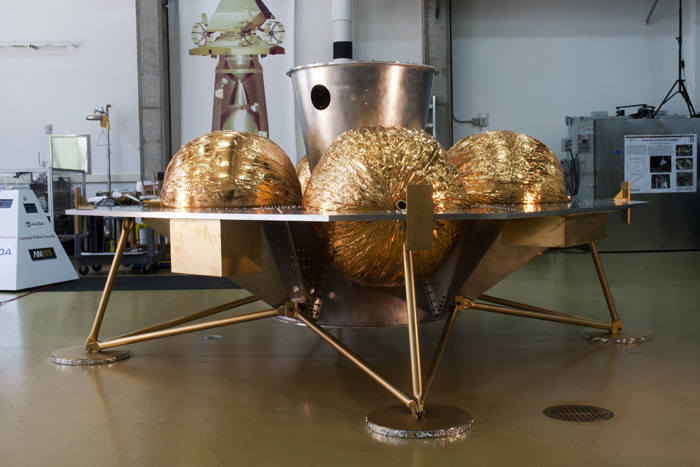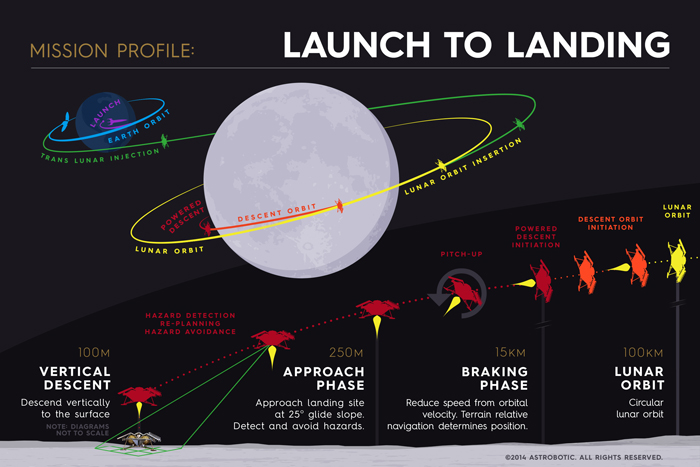
It's Time to Extend Routine Space Operations to the Moon (Op-Ed)
John Thornton is CEO of Astrobotic Technology. He contributed this article to Space.com's Expert Voices: Op-Ed & Insights.
When the XPRIZE Foundation announced the Google Lunar XPRIZE in 2007, Astrobotic Technology chairman Red Whittaker declared his intention to compete on the first day. Since then, we have worked methodically on the technology and operations for the $20 million Grand Prize. We have approached this from the outset as an opportunity to build a business.
With only a few lunar landings since Apollo, there remains a deep cultural belief that they are extraordinarily difficult and expensive. Bold, risky pursuits are called "moon shots." Indeed, NASA estimated that the Apollo program cost $170 billion in 2005 dollars — about $28 billion for each of the six landings.
In the 42 years since Apollo, space technology has matured. Most subsystems needed for lunar landing — from star trackers (cameras that measure a spacecraft's attitude relative to the stars) to propulsion — are commercially available off-the-shelf. Launches are commercially available to geosynchronous transfer orbit or trans-lunar injection. The total cost for a lunar landing that uses a launch vehicle's full capacity (versus flying a smaller mission as secondary payload) is now between $100 million and $200 million. For comparison, DirecTV's satellite fleet includes a dozen satellites that cost an estimated $700 million each.
Although the technology is now in reach, bootstrapping a new market is always challenging. Businesses and research institutions won't routinely develop lunar payloads until regular, affordable transport is assured, but the transport business won't mature until reliable payload customers justify the investment.
The Google Lunar XPRIZE — the largest international incentive prize of all time — has been essential to breaking that deadlock. In addition to the $20 million Grand Prize, the original $30 million purse includes a $5 million Second Prize and bonus prizes for specific objectives such as lunar night survival and visiting historic sites. Of the 29 teams that entered the race, 18 are still progressing. Google Lunar XPRIZE recently added Milestone Prizes totaling up to $6 million for meeting 2014 technical milestones in three categories: Landing, Mobility and Imaging. Astrobotic and Moon Express are the only two teams to advance to the Accomplishment Round in all three categories. [5 Private Moon-Race Teams Compete for Bonus $6 Million ]
NASA has also played a crucial role. In 2010, NASA committed a total of $30 million in Innovative Lunar Demonstrations Data (ILDD) contracts to six companies — including Astrobotic — to purchase the technical data from the development of robotic lunar landings. In February 2014, NASA announced the Lunar Cargo Transportation and Landing by Soft Touchdown(Lunar CATALYST) initiative, which seeks a commercial partner to develop robotic lunar lander capabilities. To date, NASA has awarded 15 contracts to Astrobotic, most of which have contributed toward Astrobotic's development of lunar mission capability.
Breaking space news, the latest updates on rocket launches, skywatching events and more!
Instead of treating payload customers with modest budgets as "secondary payload," Astrobotic focuses its mission operations on supporting them. We charge $1.2 million per kilogram to carry from 1 kg to 270 kg of payload to the lunar surface on our Griffin lander, with lower-cost options for payloads that separate from us en route. We have two dozen payloads interested in our first mission, which together exceed our capacity. Prospective customers include NASA and smaller-government space programs, commercial ventures and other Google Lunar XPRIZE teams.
A SpaceX Falcon 9 launch vehicle places Griffin into trans-lunar injection, a trajectory that will swing by the moon. This provides enough of the mission's total energy requirement that the single-stage Griffin lander can do the rest, greatly simplifying the overall mission.
Griffin then navigates along a pre-planned trajectory and performs a braking maneuver to enter lunar orbit. Up to this point, the mission relies on integration of off-the-shelf subsystems and techniques that have been developed and well tested for Earth orbit, from the launch to communications, propulsion, radio triangulation, a star tracker and an inertial measurement unit (IMU).
Griffin performs another braking maneuver to leave lunar orbit and begin its initial descent. It is at this point that Griffin departs the comfortable technological ecosystem of Earth-orbit subsystems and must rely on new capabilities developed at Astrobotic.
Astrobotic's first mission will land and explore the moon's Lacus Mortis region. Latin for "Lake of Death," Lacus Mortis is a plain of basaltic lava flows. It contains a pit that is a compelling exploration target. The pit's east wall has partially collapsed, creating an inviting ramp that could someday be traversed by a robotic rover.
The combination of radio triangulation, star tracker and IMU work well for orbit, but are not precise enough for safe landing near a pit. Terrestrial, unmanned aerial vehicles rely heavily on GPS, but that isn't an option on the moon. Instead, Astrobotic has developed proprietary vision algorithms that track the lander's position and attitude.
Griffin's autolanding system differs in several ways from systems like NASA's Autonomous Landing Hazard Avoidance Technology (ALHAT), which is designed to deliver people to the lunar surface. Griffin's autolanding system makes decisions entirely without human input. The small ground clearance typical of robotic landers requires the capability to detect tiny objects on the surface. To reduce mass, the system uses sensors with fixed pointing to provide the needed views of the surface and relies more heavily on cameras for precise location information. We rely on the precisely located, high-resolution image maps of the lunar surface from NASA orbital missions. The autolanding system is low-power, lightweight and highly accurate.
This landing approach has two significant challenges. The vision algorithms needed to achieve landing didn't exist — we had to invent them ourselves. Furthermore, the computing required to execute these algorithms doesn't exist in a form that is viable for operation in the vacuum of space. One of our Milestone Prize deliverables is demonstration of our own flight-capable computing system.
We recently demonstrated our landing approach on a vertical-takeoff, vertical-landing rocket. The rocket carried Griffin's sensors through the final descent portion of our landing trajectory, descending rapidly from 250 meters altitude, braking, and then entering a constant-velocity glide slope. As the rocket descended, Griffin's sensors scanned the ground to detect hazards and select a safe landing point. We had a flawless flight.
When we reach the lunar surface, we face new challenges. A lunar rover must have very low mass, be power efficient, and navigate rough terrain with no chance of rescue. The most difficult challenges are thermal. On Earth, the atmosphere blocks much of the sun's radiation and air provides cooling. A lunar rover operates in direct sunlight in a vacuum, where heat can only be dissipated by radiation or direct conduction. Operating terrestrial electronics in this environment would be like wrapping a laptop in blankets and running it full-bore. To complicate matters, the regolith under the rover heats to above the boiling point of water at lunar noon and drops to cryogenic temperatures at night.
In collaboration with Carnegie Mellon University and with NASA funding, we experimented to identify electronics that can survive the heat of the day and the cold of the night. Our rover architecture reflects most of the incoming radiation from the sun and the regolith, and radiates heat toward cold sky so we can operate through the hottest parts of the day.
The Google Lunar XPRIZE requires that we transmit two "mooncasts" back to Earth. This requires obtaining the necessary image resolution (720p in color) with a low-mass camera that can both withstand the shock and vibration of launch and operate in the vacuum and temperature extremes of the lunar surface. Communicating high-resolution images back to Earth is a significant challenge because of the distances involved; because the rover is so power limited, we relay imagery through the lander.
Like a modern-day Columbus, the Apollo astronauts gave us our first close-up glimpse of new territory and fired our imaginations. Now it's time for industry to return, still with excitement, but also with pragmatism. The moon offers a wealth of new knowledge of our planet and our solar system. It can teach us how to operate on a planetary surface. At some point, it will yield valuable resources. First, we have to make it a routine part of commercial space.
The views expressed are those of the author and do not necessarily reflect the views of the publisher. This version of the article was originally published on Space.com.





